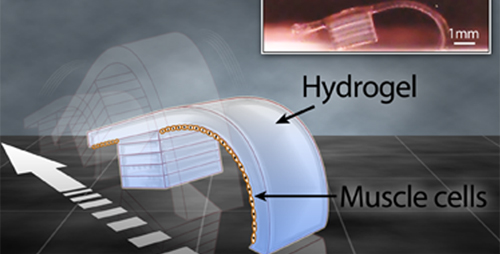· 3D Hardware
· 3D Software
· 3D Video
· 3D TV and Movies
· 3D Art
· 3D Picture of the Day
· 3D Modeling
· 3D Printing
· Reviews
· Gaming
· How To
· News
· Everything Else
· Off Topic
· Around the Web
· Virtual Reality
Posted by: Jesse on: 11/21/2012 02:44 AM
A team of researchers at the University of Illinois have begun using techniques to combine 3D Printing and biology to produce what they call "bio-bots". In a nutshell, they use use a 3D printer to make mini machine out of hydrogel, then attach heart cells to the hydrogel. The beat of the heart cell is used to propel the machine forward.
"The idea is that, by being able to design with biological structures, we can harness the power of cells and nature to address challenges facing society,” said Bashir, an Abel Bliss Professor of Engineering. “As engineers, we’ve always built things with hard materials, materials that are very predictable. Yet there are a lot of applications where nature solves a problem in such an elegant way. Can we replicate some of that if we can understand how to put things together with cells?”

The rapid prototyping abilities of 3D printing allow them to change their designs for better speed or design quickly.
In the future the team is looking to integrating neurons to direct motion or cells that respond to light.
You can check out the whole story here:
http://news.illinois.edu/news/12/1115bio-bots_RashidBashir.html
"The idea is that, by being able to design with biological structures, we can harness the power of cells and nature to address challenges facing society,” said Bashir, an Abel Bliss Professor of Engineering. “As engineers, we’ve always built things with hard materials, materials that are very predictable. Yet there are a lot of applications where nature solves a problem in such an elegant way. Can we replicate some of that if we can understand how to put things together with cells?”
The rapid prototyping abilities of 3D printing allow them to change their designs for better speed or design quickly.
In the future the team is looking to integrating neurons to direct motion or cells that respond to light.
You can check out the whole story here:
http://news.illinois.edu/news/12/1115bio-bots_RashidBashir.html

